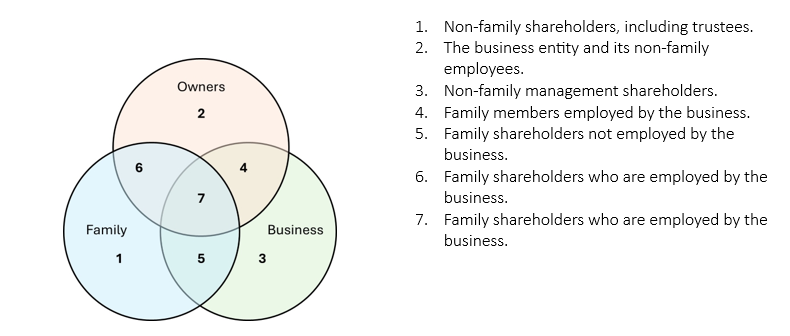Understanding the Challenge
One of the most significant risks to family-owned enterprises is the potential influence of external shareholders. This is particularly relevant given that a considerable proportion of a family’s wealth is often concentrated within the business. As such, any shareholder decision that is not aligned with the family’s long-term interests can jeopardise both the continuity of the business and the financial wellbeing of the family members who depend on it.
Strategic Response: The Ownership Strategy
To mitigate this risk, families are increasingly developing a comprehensive Ownership Strategy. This strategic document articulates how ownership of the family business should evolve to support key transitional moments, such as:
- Intergenerational wealth transfers.
- The buy-back of shares from family members seeking to exit the business or retire.
- The issuance of equity to external investors to raise additional capital.
What Is an Ownership Strategy?
An Ownership Strategy forms a critical component of a family’s broader governance architecture and serves as a cornerstone of succession planning. It provides a structured framework that harmonises the emotional, financial, and operational dimensions of ownership across generations. Specifically, it sets out:
- The long-term vision and purpose of the business;
- The family’s risk appetite and strategic ambitions;
- Mechanisms for succession, including trigger events, shareholder rights, and share class distinctions;
- Protocols for share transactions (buy, sell, repurchase);
- Agreed procedures for managing conflict and contentious issues.
A Theoretical Framework: The Three-Circle ModelThe Three-Circle Model[i] of family business, developed by Tagiuri and Davis at Harvard Business School, is widely used to understand the overlapping dynamics of the family system, the ownership structure and the business, its operations and employees.
The model identifies seven key roles:

Succession and Ownership Strategy mechanisms are typically triggered when a role 7 individual (Family shareholders who are employed by the business) steps back from the business, transitioning into one of roles:
1. Family member with no ownership and not employed by the business.
5. Family members employed by the business. Or
6. Family shareholders not employed by the business
The Ownership Strategy ensures the correct adjustment of rights and responsibilities during this transition to reflect the individual’s new role. The succession plan will provide the mechanism for the transfer of authority, duties and obligations to the next generations. It is important to note that the succession plan should be updated now to provide for the appointment of the rising generation.
Share Classes and Generational Transition
Many family enterprises adopt multiple share classes, often structured along generational lines. These may carry different voting rights or entitlements to income. Adjusting the rights associated with particular share classes is a common method of transferring wealth across generations while maintaining control within key branches of the family.
Raising Capital and Engaging with External Investors
As businesses grow, the need for additional capital may necessitate the introduction of external investors. New equity issuance can help raise funds but often comes with expectations around governance involvement and financial returns.
This shift may require the family to reduce its own income in favour of reinvestment and capital growth. If the business lacks a clearly articulated purpose grounded in family values, the introduction of external shareholders can lead to a misalignment with original family objectives.
Here, the Ownership Strategy is pivotal. It provides a framework for:
- Identifying suitable investors;
- Defining acceptable trade-offs;
- Establishing boundaries to protect family influence.
Trust Structures and Ownership
In many family businesses, shares are held wholly or partially through a trust, with remaining equity owned directly by family members. While trust structures can be highly effective for intergenerational wealth transfer, they introduce additional complexity.
The trustee, the legal owner of the shares, holds them for the benefit of the trust’s beneficiaries. From a family governance perspective, the trustee acts as an external shareholder (role 2 in the Three-Circle Model) and is bound by fiduciary duties and the provisions of the trust deed.
Crucially, the trustee is not obligated to follow family values or strategy, and must prioritise prudent, objective decision-making in line with their legal and fiduciary responsibilities. This can result in occasional tensions where the trustee’s decisions diverge from family expectations. However, this independence is a strength, ensuring commercial rigour and impartiality.
Bridging the Governance Gap: The Shareholders’ Agreement
To ensure alignment between the trustee’s role (a corporate governance function) and the family’s long-term intentions (a family governance function), it is advisable to formalise the trustee’s position through a shareholders’ agreement. This legally binding document:
- Establishes the rights and obligations of all shareholders;
- Anticipates and provides mechanism for potential disputes management;
- Ensures that decisions are taken in a manner that upholds the family’s overarching purpose and supports its strategic direction;
- Clarifies decision-making processes and exit procedures.
While the Ownership Strategy offers a guidance on the family’s purpose, values and intentions, the shareholders’ agreement is legally enforceable. The shareholders’ agreement translates the guidance set out in the Ownership Strategy into a legally binding framework. It enables trustees and other external shareholders to operate within a framework that reflects and respects the family’s strategic goals.
Conclusion
The Ownership Strategy is an essential tool for the long-term sustainability and governance of family businesses. It:
- Facilitates robust succession planning;
- Clarifies and manages evolving shareholder roles;
- Balances family influence with commercial realities and investor expectations;
- Provides clarity for trustees and other non-family shareholders on the intentions of the family.
By serving as a strategic compass, the Ownership Strategy allows families to align around shared goals, to preserve their legacy, and ensure the long-term success of the enterprise.
Should you wish you to discuss the topic in more detail or interested to hear how Boston Multi Family Office can assist you, please contact Roelf Odendaal (rodendaal@bostonmfo.com ) directly. Boston Multi Family Office is ideally positioned to assist family businesses that wish to expand internationally. We are a multi-jurisdictional fiduciary service provider with offices in the Isle of Man, Jersey, Malta and the UK that implement tailored governance solutions to clients. We embrace change, thrive in chaos and know differently.
[1] Three-Circle Model of the Family Business System | Davis and Tagiuri;, https://johndavis.com/three-circle-model-family-business-system/; 01/07/2025
